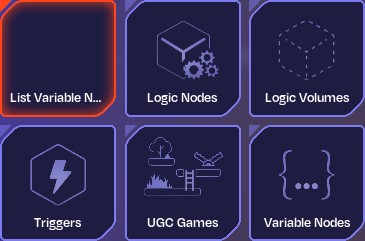Logic: Difference between revisions
No edit summary |
No edit summary |
||
| Line 19: | Line 19: | ||
<div class="video-container"> | <div class="video-container"> | ||
<b>[[A-Z_Logic_Nodes|Logic Nodes]]:</b> These are fundamental building blocks that represent various functions and events. Place these nodes in the 3D environment to define actions such as moving characters, applying forces, or handling interactions. | <b>[[A-Z_Logic_Nodes|Logic Nodes]]:</b> These are fundamental building blocks that represent various functions and events. Place these nodes in the 3D environment to define actions such as moving characters, applying forces, or handling interactions.<br><br> | ||
<b>[[List_Variable_Nodes|List Variable Nodes]]:</b> Use these nodes to manage lists of variables, such as inventories, scores, or collections of objects. They allow you to dynamically store and manipulate multiple values within your game logic. | <b>[[List_Variable_Nodes|List Variable Nodes]]:</b> Use these nodes to manage lists of variables, such as inventories, scores, or collections of objects. They allow you to dynamically store and manipulate multiple values within your game logic.<br><br> | ||
<b>[[Logic Volumes]]:</b> Spatial areas can trigger specific behaviours when objects enter or exit. For example, you can use logic volumes to create zones where players gain special abilities or encounter different physics properties. | <b>[[Logic Volumes]]:</b> Spatial areas can trigger specific behaviours when objects enter or exit. For example, you can use logic volumes to create zones where players gain special abilities or encounter different physics properties.<br><br> | ||
<b>[[Triggers]]:</b> These nodes are used to initiate actions based on specific conditions or events. Place triggers in the environment to create interactive elements like doors that open when a player approaches. | <b>[[Triggers]]:</b> These nodes are used to initiate actions based on specific conditions or events. Place triggers in the environment to create interactive elements like doors that open when a player approaches.<br><br> | ||
<b>[[UGC Games]]:</b> These nodes allow players to create and share their own game levels or scenarios. Use UGC Games nodes to empower your community to expand and personalize the game experience. | <b>[[UGC Games]]:</b> These nodes allow players to create and share their own game levels or scenarios. Use UGC Games nodes to empower your community to expand and personalize the game experience.<br><br> | ||
<b>[[Variable Nodes]]:</b> These nodes store and manage individual variables, such as health points | <b>[[Variable Nodes]]:</b> These nodes store and manage individual variables, such as health points, or environmental settings. They are essential for keeping track of game states and dynamically updating values during gameplay. | ||
</div> | </div> | ||
<!-- STAMPS --> | <!-- STAMPS --> | ||
Revision as of 13:27, 20 May 2024
Logic is a powerful visual scripting system that lets you create game logic without needing to write code. It is designed to be user-friendly and accessible, even for those who are not familiar with traditional programming.
In ARCADIA, logic is a visual scripting tool that you can place directly within the 3D world, your ARC. Logic is only visible while you are in Build mode, and invisible in Play mode. Think of logic as interactive objects that represent various functions, variables, and events. Each logic node performs specific actions, such as moving characters, triggering animations, or handling player input.
To create game logic, you simply drag and drop these logic nodes from the catalogue into the 3D environment. Once placed, you can connect them using visual links, which represent the flow of actions and data between different nodes and objects. This approach allows you to see and interact with your game logic in a spatial context, making it easier to understand and manage complex behaviours.
Logic types
Logic Nodes: These are fundamental building blocks that represent various functions and events. Place these nodes in the 3D environment to define actions such as moving characters, applying forces, or handling interactions.
List Variable Nodes: Use these nodes to manage lists of variables, such as inventories, scores, or collections of objects. They allow you to dynamically store and manipulate multiple values within your game logic.
Logic Volumes: Spatial areas can trigger specific behaviours when objects enter or exit. For example, you can use logic volumes to create zones where players gain special abilities or encounter different physics properties.
Triggers: These nodes are used to initiate actions based on specific conditions or events. Place triggers in the environment to create interactive elements like doors that open when a player approaches.
UGC Games: These nodes allow players to create and share their own game levels or scenarios. Use UGC Games nodes to empower your community to expand and personalize the game experience.
Variable Nodes: These nodes store and manage individual variables, such as health points, or environmental settings. They are essential for keeping track of game states and dynamically updating values during gameplay.

Logic Nodules